Chapter 10 Biodiversity And Its Classification
Would you face any problem if you are asked to write the names of some living organisms such as plants or animals around you?
I am sure you wouldn’t face any problems. You can write many pages without any hesitation. There are several life forms in our earth. Living forms are a little bit to a great different from each other.
This variability is known as biological diversity or biodiversity. Biodiversity is the term used to describe the variety of life in the earth. It includes every plant and animal as well as microorganisms such as bacteria and viruses.
Viruses are between living and non-living forms. Viruses are living when they are inside living organisms. But you cannot get all the living forms in a particular place or location. Biological diversity is not evenly distributed over the earth’s surface.
Read and Learn More WBBSE Notes For Class 6 General Science and Environment
Chapter 10 Biodiversity And Its Classification Simply Biodiversity Is The Number And Variety Of Living Forms In A Particular Place.
You can study the biodiversity of plants and animals in your locality. Make a table of different plants and animals of your locality. How many varieties of plants and animals are there and their number in a particular place. Simply that is the biodiversity of that place.
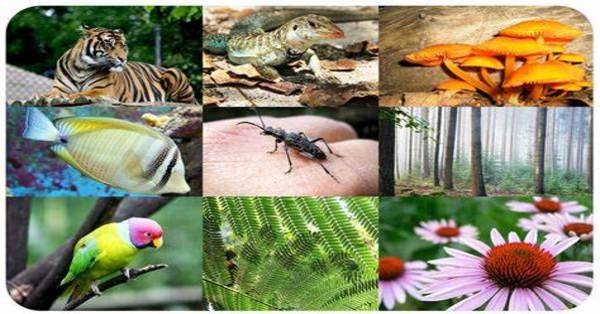
Complete the table
| Organisms | Number | Varieties | Remarks |
| 1. Plants | |||
| 2. Animals | |||
| 3. Other organisms |
Now the question is how many species exist on our earth? Exactly how many species of life exist on earth is not known. However, it estimates range from 20 to 50 million (2 to 5 crores) or more than that.
Among the vast number of living forms (species) nearly 1.9 million (Nineteen lacks) species are identified all over the world. They are given scientific names. A large number of species are yet to be identified.
Now let us see what is species.
You have seen tigers, different types of dogs, pigeons, crows, cows, cats as well as different types of mango trees, ornamental plants, etc.
Among them, some animals or plants have similar features but some have different ones. Living forms or organisms having the same features are known as species.
- The term ‘Biodiversity’ was coined by Walter G. Rosen, in 1985.
- E. O. Wilson popularized this word. Wilson is often called the father of Biodiversity.
- Members of a species have close similarities (same features) and more or less have the same type of gene and they reproduce within themselves only.
- All humans are single species Homo sapiens.
Such as Rohu fish is Labeo rohita. Bata fish is Labeo bata. A common mango plant is Mangifera indica. Pea plant is Pisum sativum.

If you follow crows in your locality you may find some have a grey part around the neck region but some have not so and totally black in color. There are two different species of crow, the former is Corvus splendens (Pati kak), and the latter is (raven) Corvus corax.
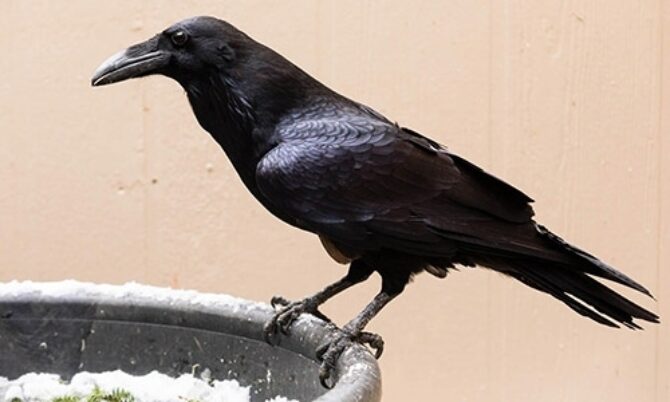
Such as Tiger-Panthera tigris, Cat-Felis catus. These are the scientific name of these organisms. Now the question what is the necessity of giving a scientific name to a living organism?
Most of the animals and plants have a local name, such as Tiger, (English name) is known as ‘Bagh’ in Bengali, ‘Sher’ in Hindi, ‘hu’ in Chinese, and ‘Huli’ and ‘Puli’ in somewhere. So it creates confusion to identify the actual animal.
To solve this problem scientists consider the features of that organism (animals, plants or microorganisms), and a scientific name is given to that particular organism.
For example, the scientific name of the Tiger is Panthera tigris. This animal or Tiger is known as Panthera tigris all over the world. The scientific name of the Tiger is Panthera tigris.
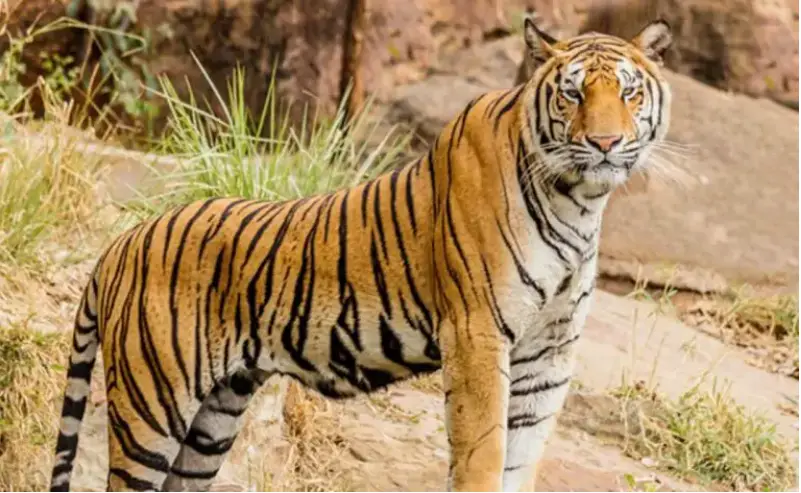
Like this all human beings of our earth whatever their religions and race, color, and height belong to the same species-Homo sapiens. This is the scientific name of humans.
- The scientific name has two parts-first word is known as ‘genus’ and the second word is known as ‘species’.
- Such as in Panthera tigris
- ‘Panthera’ is genus and ‘tigris’ is species.
- Scientist Carolus Linnaeus introduced this naming procedure. This is known as Binomial nomenclature.
So far scientists have identified nearly 1.9 million (nineteen lacks) species. Still, a lot to be identified. But now the question arises of how these vast numbers of species to be kept properly in an organism table.
To avoid confusion, Taxonomists (Scientists that deal with this part of biological science) have classified these organisms in scientific methods. Biological classification is the way biologists use to categorize and organize all the life in earth.
Have you Noticed How Medicines Are Kept In Medicine Shop And Books In The Library
If you notice carefully that the medicine shopkeeper and librarian keep medicine and books respectively in a definite order. Librarians arrange books in different racks in a particular order-subjectwise, classwise, and sometimes alphabetically like A-Z.

Medicine shopkeepers also arrange different medicine in racks or boxes alphabetically from ‘A’ to ‘Z’. So they are able to deliver books or medicines as soon as the demand is placed.

Similarly, all living organisms are classified into groups based on very basic shared characteristics. Organisms within such groups are then further divided into small groups.
Scientists have arranged this living forms in definite order or rule on the basis of similarities and dissimilarities. The scientific arrangement of different living forms (species) on the basis of similarities is known as classification.
Classification of living forms has many steps. The major first step of classification is the kingdom. Though some Taxonomists introduce a category (rank) over the kingdom is known as the Eight levels of modern classification
Steps are-
- Domain
- Kingdom
- Phylum
- Class
- Order
- Family
- Genus
- Species
‘Domain’. They placed all organisms under three domains. Under these domains, six kingdoms are placed. More or less acceptable six kingdoms are
- Bacteria
- Protozoa
- Chromista
- Fungi
- Plantae
- Animalia.
In some other type of popular classification (R. H. Whittaker, 1969) organisms are placed under five kingdoms.
They are
- Monera
- Protista
- Fungi
- Plantae and
- Animalia.
In some recent classification, organisms are placed under three domains, the first rank of classification.
3 domains are
- Archaea
- Bacteria.
- Eukarya(by Carl Woese)
Kingdoms
- Monera-Prokaryotes (have no true or typical nucleus)
- Protista-Unicellular eukaryotes (which have typical nucleus)
- Fungi-Including all fungi.
- Plantae-All photosynthetic plants.
- Animalia-All animals.
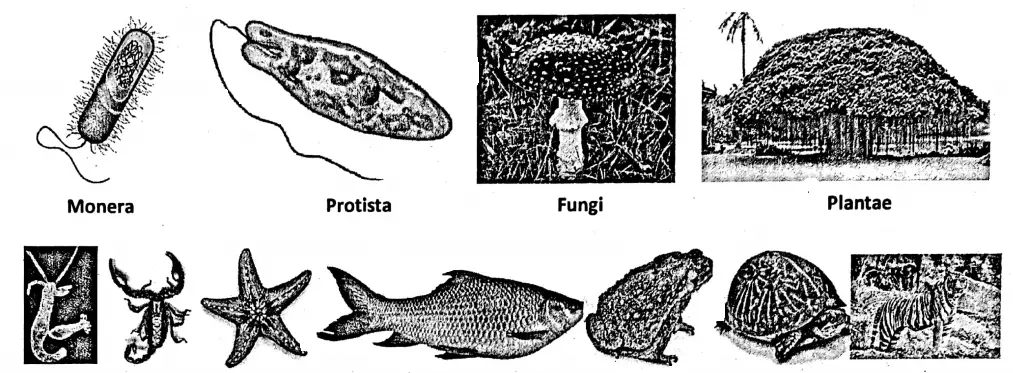
Viruses are not placed in any type of classification because they are not truly living organisms. They are treated in between living and non-living forms.
They only grow (reproduce) when they are enter into a living organism’s body. But outside the living body virus is non-living (no sign of a living organism).
Chapter 10 Biodiversity And Its Classification History Of Classification
From the dawn of civilization, many attempts have been made to classify living organisms. The biological classification of plants and animals was first introduced by Aristotle Linnaeus and later classified all living organisms into two kingdoms (Two kingdom classification).
- Plantae (Plants) and
- Animalia (animals) that include all plants and animals respectively.
Classification of organisms into plants and animals was easy to understand, but a large number of organisms did not fall into either category. After many attempts, R. H. Whittaker (1969) proposed a five kingdom classification, which is very popular.
Later Cavalier-Smith’s and others classified organisms into six kingdom.
Kingdom Bacteria
They are single-celled prokaryotic microscopic organisms. They have the simple primitive type of nucleus. In five kingdom classific- action Bacteria are placed within the kingdom Monera.
Some members of this kingdom are harmful to humans as well as other plants and animals. Bacteria are responsible for many human diseases such as tuberculosis (TB), Typhoid, Cholera, Diarrhea, etc. But some are beneficial too.
Example-Salmonella typhi, Vibrio cholera, Rhizobium, etc.
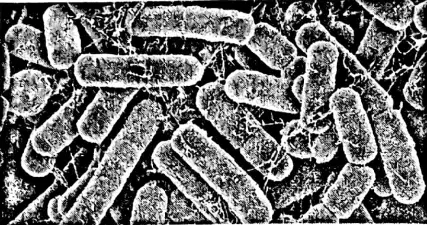
Kingdom Protozoa
Protozoans are single-celled eukaryotes (having typical nuclei) either free-living or parasitic. Which feed on organic matter such as other microorganisms or organic tissues and debris.
Examples-Amoeba, Entamoeba (germ of amebiosis), Plasmodium (germ of Malaria), etc.
Thomas Cavalier-Smith et. al 1981, has ranked protozoa as a kingdom. In the five kingdom classification, they are placed within the kingdom Protista.
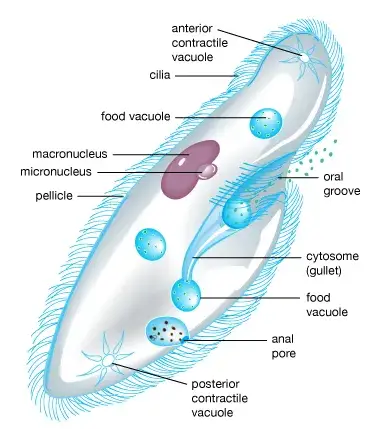
Kingdom Chromista
This is an eukaryotic kingdom. They include the group of colored algae as well as various colorless forms that are closely related to plants. Details of this kingdom are not yet known.
Example-Macrocytis kelp, Diano-flagellates, Foraminifera, some marine algae etc.
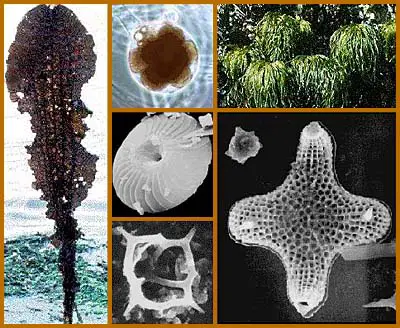
Chloroplast contains chlorophylls ‘a’ and ‘c’. Photosynthetic chemists often carry various pigments in addition to chlorophyll which are not found in plants. Kingdom chloroma is distinguished from plants because of the more complex chloroplast.
Kingdom Fungi
Mushrooms, Yeast, Mucor, and other pigment less forms which are unable to produce their own food. They absorb nutrition from (heterotrophs) other organism’s body.
Some fungi are harmful some are beneficial. Some mushrooms are edible. Some are not. Some fungi help in alcohol and bread formation.
Example-Toadstools, Penicillium, Yeast, Mucor, etc.
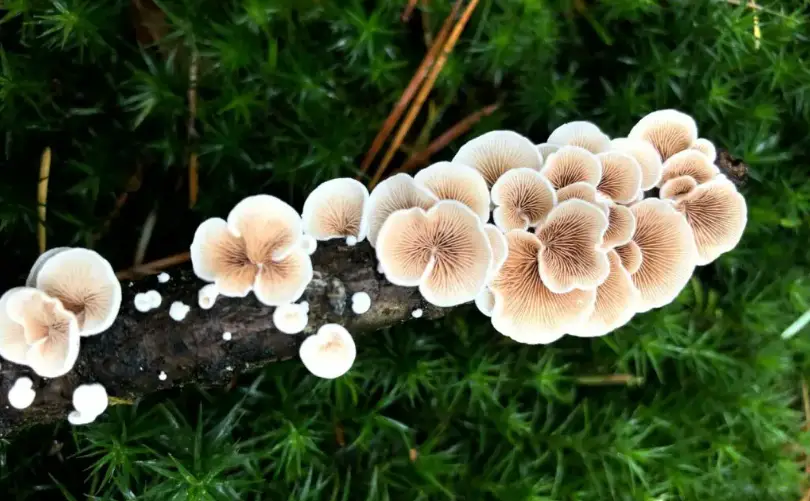
Kingdom Plantae
All plants belong to this kingdom. Chlorophyll present in their body. They can produce their own food with the help of chlorophyll.
Example-All green plants.
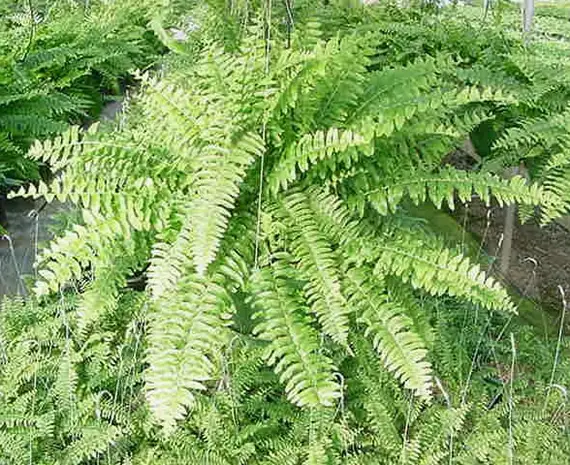
Kingdom Animalia
All animals from sponges to man. are placed within this kingdom. They have sense organs. Animals are unable to produce their own food.
Example-Sponge to humans, all animals.
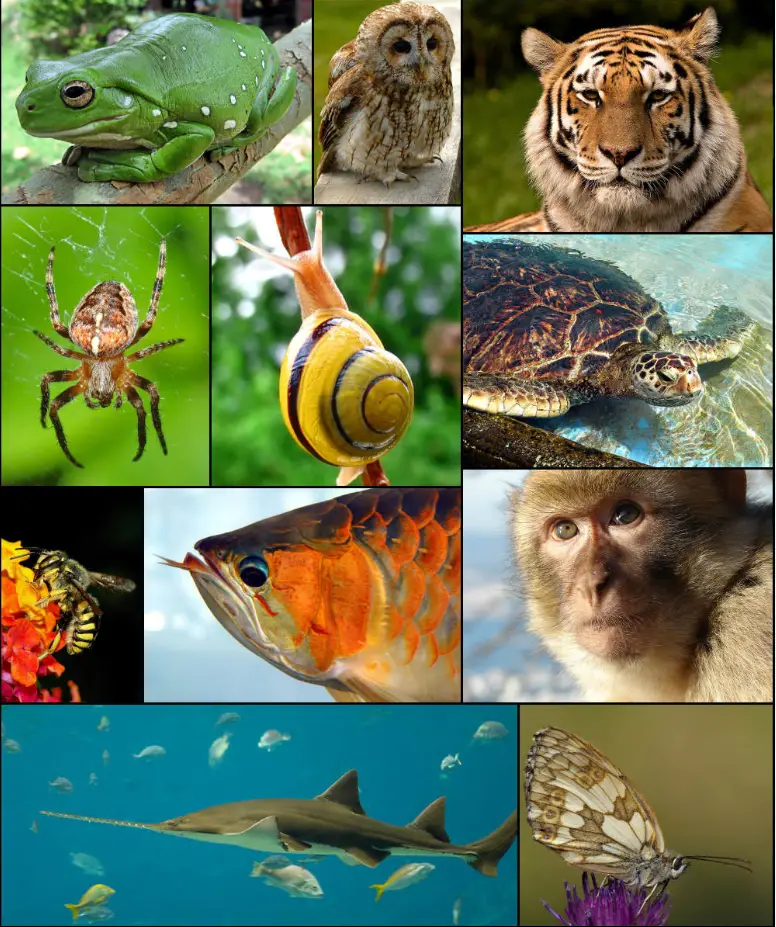
Five Kingdom Classification
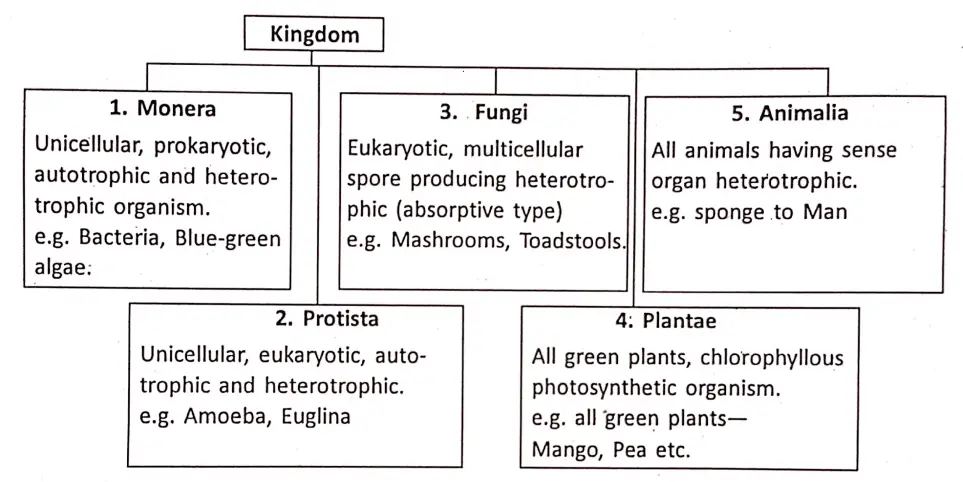
All of you may have seen earthworms, ants, cockroaches, snails, jellyfish, prawns, crabs, etc. in nature. Have you seen any backbone or internal spine or hard internal structure of these animals?
On the other hand, you have seen fish, toads, snakes, tortoises, birds, cows, goats, etc. The animal of the first group have no internal hard structure, some may have external hard structures (shells of snails) or covering (cockroaches, ants,s, etc).
But the animals of the second group possess a hard internal structure. The first group of animals who have no hard internal supporting structure are known as invertebrate animals and the animals of the last group who have hard internal bony structures are known as vertebrate animals.
Make a list of vertebrate and invertebrate animals in your locality.
Complete The Table
| Locality | Date/year | Invertebrates | Vertebrates |
| 1. | 1. | ||
| 2. | 2. | ||
| 3. | 3. | ||
| 4. | 4. |
Now all of you have understood that vertebrates have a hard internal bony structure which is known as the vertebral column. Whereas invertebrates have no vertebral column.
The animals of the animal kingdom are placed under some phylum (rank below the kingdom) on the basis of the simple to complex nature of the body construction of the animals.
If you examine the legs and antennae of prawns, crabs, cockroaches you will see these organs are made up of many small parts. If you pull two ends of these organs parts will be separated easily.

Therefore, the appendages of these animals are joined. So these animals are placed under phylum Arthopoda (Artho = jointed, poda = leg). Body of these animals are covered with a hard covering that contains a specialized nitrogenous substance known as a cuticle.
If you carefully observe their eyes you may see these are made up of many small eyes. These eyes are called compound eyes. Insects like fly, mosquitoes, moths, and butterflies are also included in this group (Arthopoda).
Many of you may have seen snails, and oysters and some of you may also have seen octopuses, and squids (in sea or aquarium). Octopus, sepia, and Loligo have no outer hard covering. Sepia and Loligo have calcareous internal hard plate-like structures.

All these soft-bodied, unsegmented animals are placed under the phylum (group) Mollusca (phylum-Mollusca). Snails, and oysters have hard outer shells (coverings) made of calcarious materials.
Mollusks have a soft ventral muscular leg for their movement (in some forms legs are modified into other forms).
Insect
Insects are arthopodes. This is the largest animal group (class) among the animal kingdom. They are found in land, air, and water. The most successful group of animals appeared in the earth nearly 40 crores years ago.
Insects have three pairs of legs and usually with two pairs of wings. Their body is divided into three parts-Head, thorax, and abdomen.
Example:
Dragonflies, grasshoppers, ants, beetles, wasps, aphids, butterflies, mosquitoes, flies, cockroaches, etc.
A large number of animals inhabit the earth today. These animals vary in shape and size, habit and habitat, colors, weight as well as in their distribution.
Kingdom Animalia is broadly divided into two major groups-Non-chordates (groups of lower and simple animals) and chordates (groups of higher and complex animals).
The majority of chordates have hard internal bony structures, and vertebral columns. These animals are placed under the rank (group) vertebrate.
The chordates who have no vertebral column are called lower chordates or invertebrate-chordates (e.g. Balanoglossus, Amphioxus, etc.) Lets see some important animal groups (phylum) and their salient features habitats and common examples.
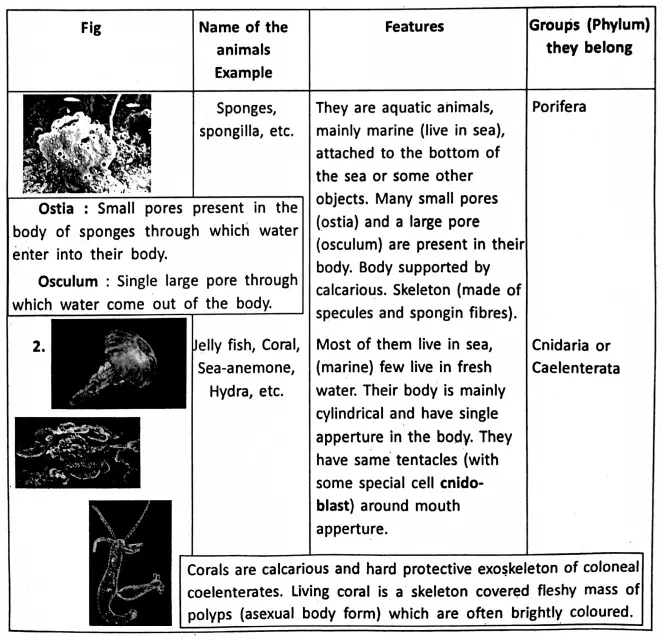

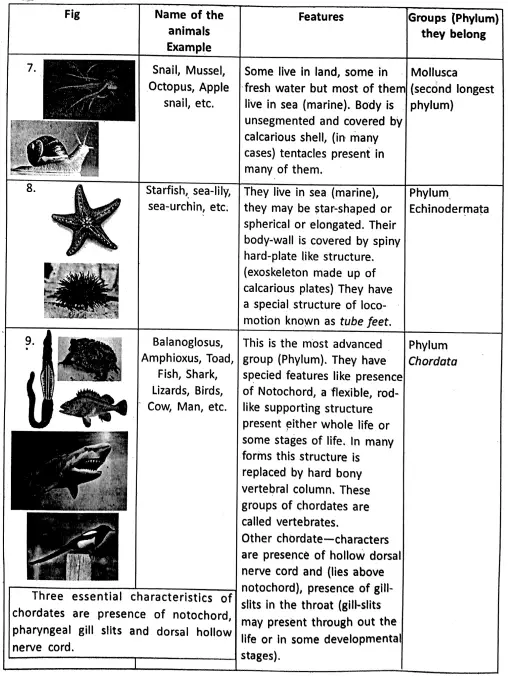
- Invertebrates have no notochord. In all chordates, the notochord is present either throughout life or early (developmental) stages of development.
- In vertebrates, the notochord is replaced by the bony vertebral column.
All vertebrates possess notochord in their developmental stages but are replaced later by the bony vertebral column. But in a few chordate members notochord remain as notochord throughout life or for a certain period but no replacement occurs.
These chordates are known as lower chordates or invertebrate chordates. Examples are Balanoglosus, Amphioxus, Acidia, etc. Vertebrates are divided into six classes. You can separate them externally observing their features. Let’s see some important features of them.
Chapter 10 Biodiversity And Its Classification Vertebrates
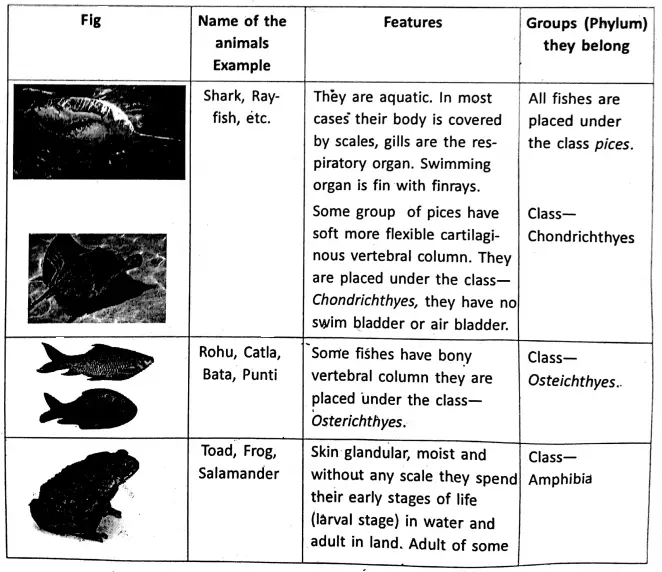
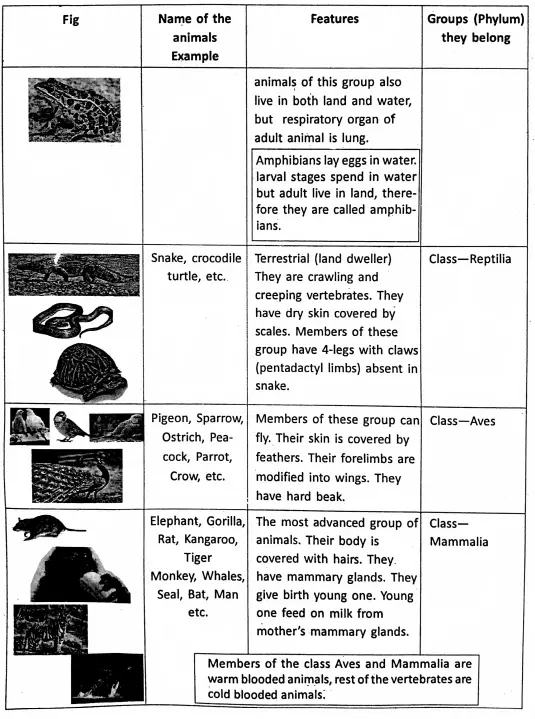
Arrange the following animals in their respective groups (phylum/class) and write/remark why you placed them to that group (Phylum/class).
Chapter 10 Biodiversity And Its Classification Animals
Human, shark, toad, leech, earthworm, frog, monitor-lizard, crocodile, cockroach, cobra, whale, tortoise, vulture, owl, pea-cock, fox, lion, rat, cat, koi fish, ray fish, snail, octopus, corals, tapeworm, roundworm, mosquito, fly, spider, starfish, sea-urchin, salamander, orangutang.
| Animals | Group Phylum/class | Remarks (Why they are kept in this group) |
| Example: 1. Human | Phylum—Chordata | 1. Body covered with hairs |
| Class—Mammalia | 2. Presence of mammary glands | |
| 3. | ||
| 2. | ||
| 3. | ||
| 4. Leech | Phylum—Annelida (invertebrate) | 1. Soft segmented body sucker present |
| 5. | ||
| 6. | ||
| 7. | ||
| 8. | ||
| 9. | ||
| 10. |
Fill in table
| Features of vertebrate animals | Types of vertebrate (class) |
| 1. Live early stages of life (larval stages) in water, adult in the land. | 1 |
| 2. Body covered by feathers. | 2 |
| 3. Have a vertebral column (bony) and gill is the respiratory organ. | 3 |
| 4. Body is covered by hair. | 4 |
| 5. Give birth young one who doesn’t lay eggs. | 5 |
| 6. Body covers with dry scales. | 6 |
| 7. Presence of fin with fin-rays. | 7 |
| 8. Vertebral column made of cartilage. | 8 |
| 9. 4 legs with claws. | 9 |
Complete the table
| Features | Group | Example |
| Example: 1. Presence of tube-feet | 1. Echinodermata (Phylum) | 1. Starfish |
| 2. Flat body head with hooks and suckers. | 2. | 2. |
| 3. Round body tapering at both ends present in the human intestine. | ||
| 4. Soft segmented body | ||
| 5. Body with jointed appendages | ||
| 6. Presence of ventral muscular foot. | 6. Mollusca | 6. Snail |
| 7. Skin with calcareous spines | ||
| 8. Soft, cylindrical body with single aperture | ||
| 9. Body covered by hard calcareous shell | ||
| 10. Simple body with many pores, mainly marine | ||
| 11. Presence of compound eyes. | ||
| 12. Invertebrate body with internal calcareous skeleton |
Complete the table
From the following examples (animals) pick the animals of the same group and put them in a Box
Chapter 10 Biodiversity And Its Classification Animals
- Dog
- Koi fish
- Shark
- Corals
- Dolphin
- Penguin
- Poller Bear
- Magur
- Sponges
- Hydra
- Octopus
- Tortoise
- Crocodile
- Toad
- Butterfly
- Whale
- Cobra snake
- Owl
- Kite
- Fox
- Sparrow
- Crow
- Rat
- Ray-fish
- Salamander
- Lizard
- Tapeworm
- Starfish
- Filaria worm
- Leech
- Sea-urchin
- Earthworm
- Spider
- Vulture
- Sea lily
- Jellyfish
- Scorpion
- Pigeon
- Roundworm
- Deer
- Rhinoceros
- Kangaroo
- Oyster
- Lion
- Sepia
- Man
- Monkey
- Whale
- Dolphin
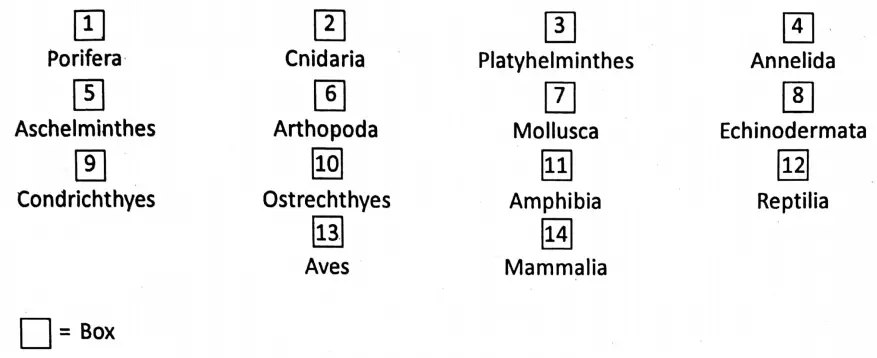
Complete The Table
From the above examples select invertebrate and vertebrate animals and put them in their respective box.
| Invertebrates | Vertebrates | ||
| Example | Phylum/class | Example | Phylum/class |
| Sponges (9) | Dog 1 | ||
| Put the animals (from the figure) to their respective phylum/class) | |||
Kingdom Plantae
All of you have seen plants of different types, some are long, some are medium and some are small to very small. Some plants can’t stand erect some are not, they creep along the soil or climb up with the help of support.
Plant kingdom-Plantae :
Most plants are green. They possess green pigments and chlorophyll in their body. Plant makes its own food by photosynthesis (a process by which plant makes their food with the help of sunlight, chlorophyll, water, and carbon dioxide).
There are various plants in nature. Some of them are long-lived and some are short-lived. There are usually three types of plants besides very small plants like algae.
Chapter 10 Biodiversity And Its Classification Phylum Class Plants
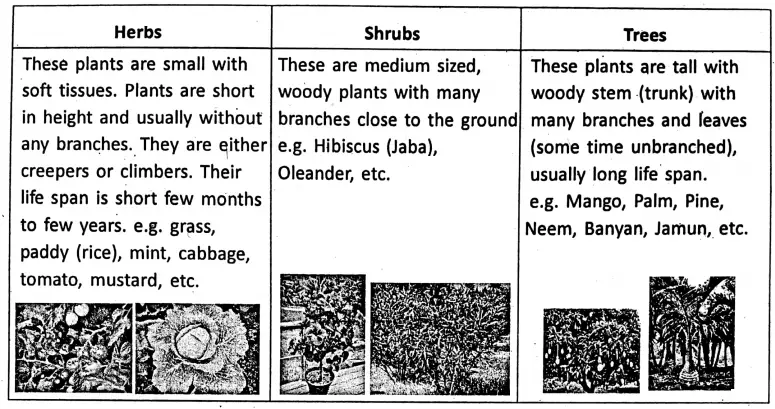
Try to collect different types of plants and try to understand the difference between them (Take help from your teacher):
| Points/Questions | Herbs | Shrubs | Trees |
| 1. Have any woody stem | 1. No | 1. Yes | 1. Yes |
| 2. Have any trunk | 2. No | 2. No | 2. Yes |
| 3. Height of the plant | 3. …….. | 3. …….. | 3. …….. |
| 4. Branches | 4. ………. | 4. ………. | 4. ………. |
| 5. Life span | 5. ………. | 5. ………. | 5. ………. |
| 6. | |||
| 7. | |||
| 8. |
Complete The Table
Pick up the plant from the list (below) and place it to its proper place.
- Potato
- Pumkin
- Bitter melon
- Water melon
- Paddy
- Banana
- Mango
- Hibiscus
- Palm
- Rose
- Ginger
- Maize
- Coconut
- Amlaki
- Mint
- Bael
- Neem
- Garlic
- Sundari
- Shal
- Water hyacinth
- Grass.
| Herbs | Shrubs | Trees |
| 1. | 1. | 1. |
| 2. | 2. | 2. |
In the summer or rainy season when we swim in ponds or rivers, we often meet some water weeds. Some are floating, some are underwater like ribbons. Many of you have experienced how to walk on a slippery surface in the bathroom, pond side ‘ghat’ etc.
If you carefully observe the surface you may find some greenish or brownish surfaces. These are the algae. Algae are a type of plant. They have no roots, stems or leaves.
They do not have flowers (non-flowering plants) but they can make their own food in their bodies because they have chlorophyll. Algae often float freely in lakes, ponds, and oceans.
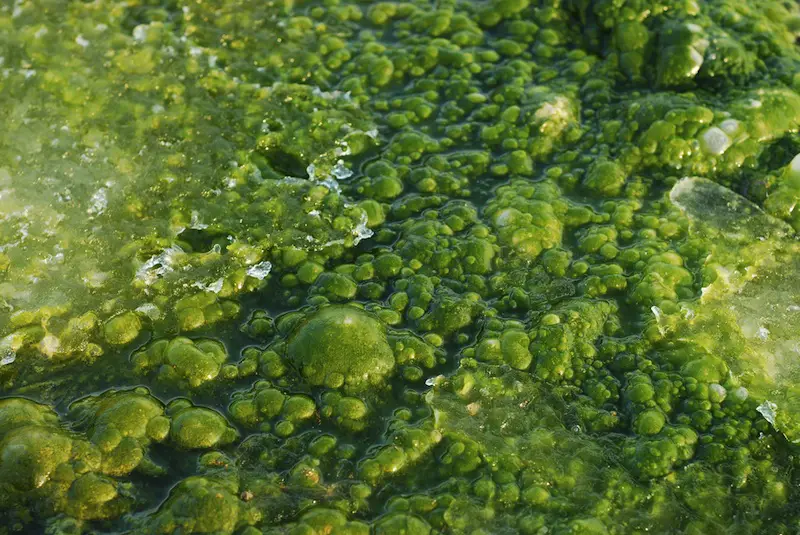
Sometimes they fix themselves with some objects. You can see some ribbon-like or thread-like algae in the pond. These long ribbon-like slippery algae are known as water silk (Spirogyra).
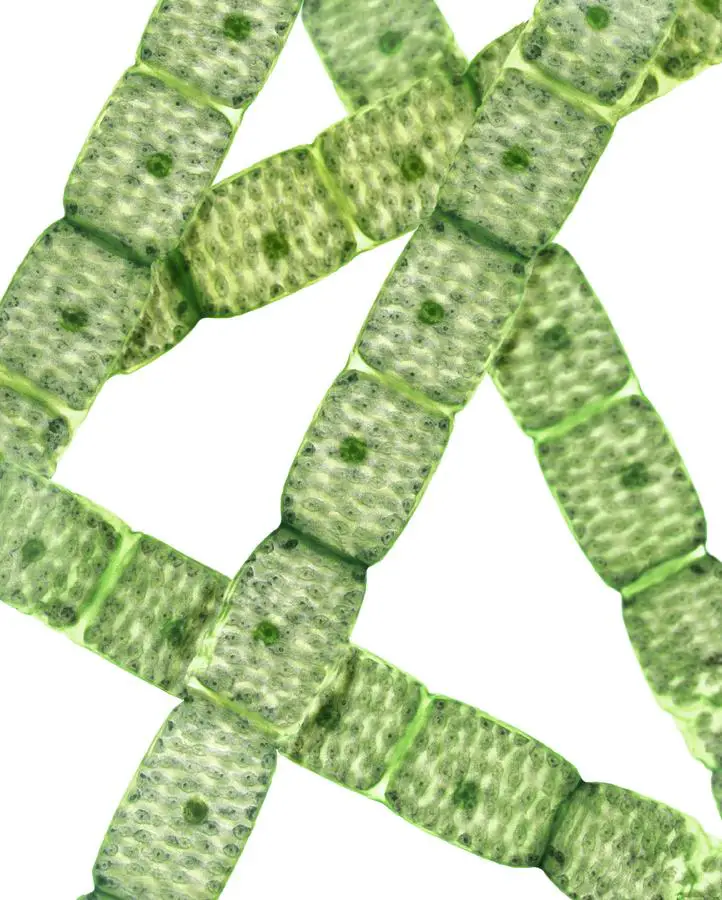
Most of the algae are simple thallus-like and without any root, stem or leaves. They are aquatic or grow in a moist places. Algae are placed under the group Thallophyta.
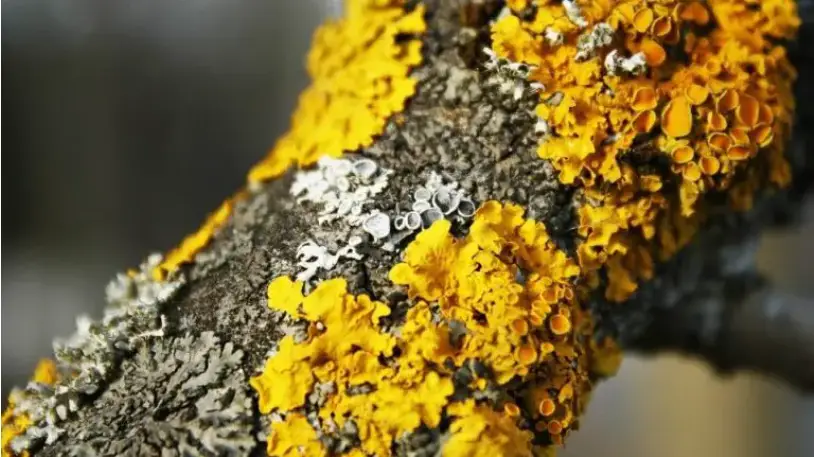
Algae
(singular. Alga) Algae are mainly aquatic, non-flowering, photosynthetic (can produce their own food) having chlorophyll and other pigments but lack of true root, stem, and leaves.
Thallophyta
A group of plants or plant-like organisms, whose body is thallus like have no root, stem or leaves. Algae and some fungi are examples of Thallophyta.
During monsoon or autumn, many of you have seen a thick green mat that grows on the surface seen mostly in the lawns, moist old boundary walls of your school or home, or in rocky surfaces in forests, tree trunks, etc.
These are moss-like plants (See picture). These moss-like plants are placed under the group Bryophyta. They include liverworts, hornworts, and mosses.
Bryophytes live in humid (moist) and shaded places. Bryophytes are non-flowering plants. The main body of bryophytes is more or less thallus-like (Ricca) plants. They do not have true roots, stems, and leaves.
They generally have something similar to a root, which is known as rhizoids. Which absorbs water from the substratum (the place to which the plant is attached).
But some bryophytes have leafy (not true leaf) erect structures which bear capsule-like spore-bearing sacs when the capsule dies off, spores (powder-like small grains) come out and fall on the moist surface.
New plants grow from these spores. example Moss, Liverwort, Pogonatum, etc. Bryophytes are called the amphibians of the plant kingdom. Though they grow in terrestrial environments (land area) they are dependent on water for the reproduction process.

Many of you have seen Fern as an ornamental plant in some gardens or roadside. You may have eaten Shushnishak, Dhekishak, etc., and attending a height of up to six Tree ferns have full trunks meters.
All these plants are placed under the group Fern-like plant or Pteridophyta. They are generally terrestrial in habitat occurring in moist shady places over the soil. Sometimes they also grow on other trees.
Pteridophytes have leaves, roots, and sometimes true stems. Stems are usually covered by brown scaly leaves (ramenta). Pteridophytes are non-flowering plants.
They have feather-like leaves (compound). Young leaves of fern is coiled at the tip (look like dog tail). If you look underside of mature fern leaf you will fine brown or blackish dot-like or sac like hard structures.
It bears spores. Now plants grow from these spores through some stages. intermediate position between Pteridophytes occupies the intermediate position between Bryophytes and Phanerogams (flowering plants).

Fern and moss have two stages in their life cycle sporophytes stage (bear spore) and gametophytes (bear games) From the above discussion you have learned three types of plant groups under the non-flowering group (Cryptogam, seedless plants).
They are Thallophyta (alga), Bryophyta (moss-like plant), and Pteridophyta (fern-like plants). Besides these, there is a large group of seed-bearing plants (mainly flowering plants or phanérogamae or Spermatophyta) around us.
The main plant body has true root, stem, and leaves. If you compare a Pine (pinus) tree with a Mango tree you can see the difference between their leaves, their fruits, and seeds.
Seeds produced by Pine (pinus) are naked and are not enclosed within fruits, but the seed of the Mango plant is enclosed within the fruit. You may also find differences in their leaves. The leaves of Pinus is needle like whereas the leaves of Mango is flat.
Pine (gymnosperms) have no flowers or fruits and have ‘naked’ seeds on the lower surface of leaves. The seeds are arranged together in a circle (forming a cone). Whereas Mango’ plant is a flowering plant and has a seed that is enclosed within the fruit.
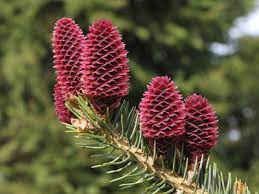
The former plant (Pinus) group is known as Gymnosperm and the later plant group (Mango) is known as Angiosperm.
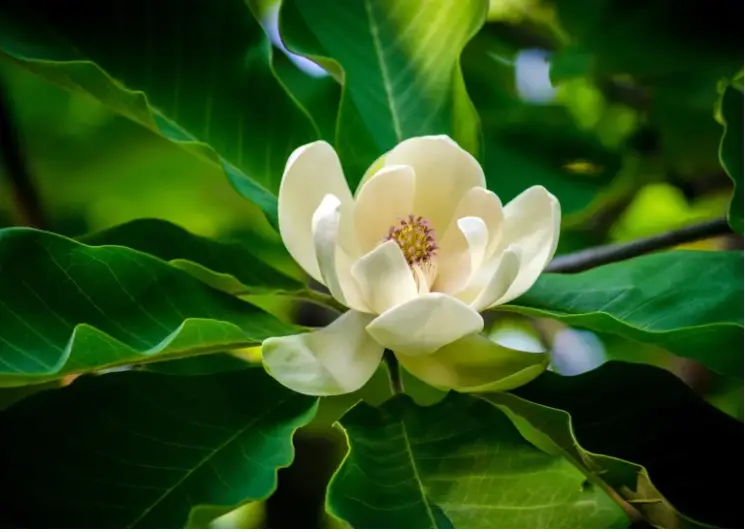
Both Gymnosperms and Angiosperms are included under Spermatophyta or Phanerogamae (seed-bearing plants)
Gymnosperm
These are the seed-bearing plant group having no flowers and fruit seeds are naked (uncovered).
Example Cycys, Pinus, Casarina.
Angiosperm
These are the seed-bearing flowering plant group where seeds are enclosed within the fruits.
Example Mango, Neem, Apple, etc.
Angiosperms are seed plants, they have flowers and seeds and are produced inside fruits. They occur in all types of habitats dry, wet, and temperate areas.
Difference between Gymnosperm and Angiosperm
| Question | Gymnosperm | Angisosperm |
| 1. have any flowers? | 1. | 1. |
| 2. Have any fruit? | 2. | 2. |
| 3. Location of seeds. | 3. | 3. |
| 4. Example | 4. | 4. |
Make a list of Gymnosperm plants and Angiosperm plants
| Gymnosperm plant | Angiosperm plant |
| 1. | 1. |
| 2. | 2. |
| 3. | 3. |
Take some seeds of Pea (motor) or Bengal Gram (Chola) and Paddy (Dhan). Then remove their outer cover (dry cover), and give little pressure to both type of seed [Pea seed and Paddy (rice)] you may see.
Pea seed has two semicircular halves but Paddy (rice) has one long portion with little whitish mark at the end. Then two halves of pea seed and a single part of paddy is known as cotyledons.
Pea (and gram) is dicotyledon seed (having two cotyledons) and paddy (rice) is a monocotyledon seed (having one cotyledon). Dicotyledon seed-bearing plants are known as dicotyledons and monocotyledon seed-bearing plants are known as Monocotyledons.
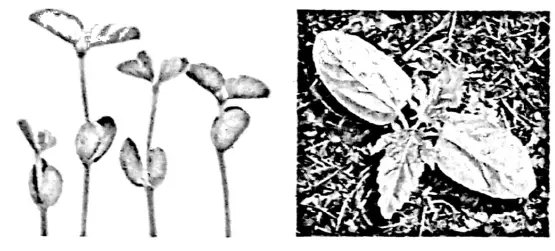
Monocotyledons bear seeds that have a single cotyledon or seed leaf.
Example: Rice, Grass, Sugarcane, Wheat, Bamboos, Maize, etc.
Dicotyledons bear seeds that have two cotyledons or seed leaves.
Example: Grams, Peas, Beans, Sunflower, rose etc.
Place the plants in the box below. Ginger, Banana, Wheat, Rose, Ground nut, Potato, Plam, Maize, Tomato, Pea, Garlic, Onion, Hibiscus, Eucalyptus
| Monocotyledons (monocots) | Dicotyledons (dicots) |
| 1. | 1. |
| 2. | 2. |
| 3. | 3. |
| 4. | 4. |
- Take one leaf of the banana plant and one mango leaf. Look carefully.
- Do you notice any difference of the colour of the two surfaces?
- What are the arrangement of veins in two leaves? Is it the same?
| Question | Banana leaf | Mango leaf |
| 1. How many veins in the middle? | Single midvein | Single midvein |
| 2. Types of arrangement of veins in the leaf blade? | Side branches run paralleled from mid-vein without meeting each other. | Side branches coming from the mid vein meet with each other and form a network of veins. |
| 3. Meeting of side branches of veins occur | No | Yes |
| 4. Type of venation | Parallel venation | Reticulate venation |
| The arrangement of veins in a leaf blade is called venation. | ||
Now you have an idea about venation. Monocots have parallel venation while dicots have reticulate venation. Try to collect different leaves and examine their venation.
Complete The Table
| Plant leaf | Type of venation Parallel / Reticulate | Type of plant Monocots / dicots |
| 1. | ||
| 2. | ||
| 3. | ||
| 4. |
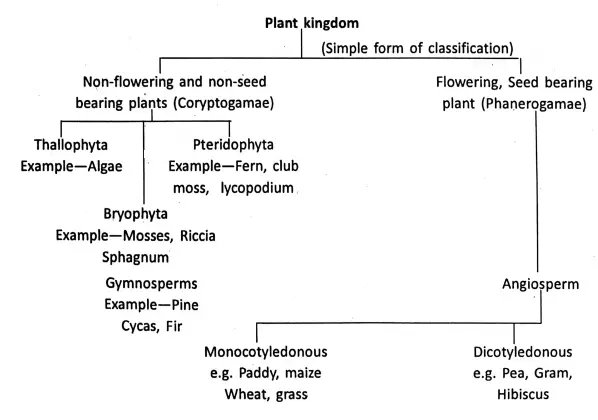
Try To Summarise your Understanding
- Mango is a (Angiosperm / Gymnosperm) plant.
- The venation of sugarcane leaf is (parallel/reticulate).
- Banana is a _______________ (Dicotyledonous / monocotyledonous) plant.
- You are given a leaf that has the reticulate type of venation; the plant is _______________ (Monocotyledonous / Dicotyledonous).
- Pinus bears fruit (yes/no).
- Plants have no root, stem, and leaf are ________________ (algae/bryophytes/ pteridophytes).
- Rizoids present in ________________ (algae / bryophytes / pteridophytes).
- Body divisible into root, stem, and leaves but has no flower the plant is ________________ (Bryophytes /Pteridophyts/Gymnosperms).
- Water-silk, Spirogyra is a _____________ (algae / Moss/Fern).
- ‘Sorus’ is found in (Spirogyra / Moss / Fern).
- A parallel type of venation is usually found in (Monocotyledonous / Dicotyledonous/plants).
- Pea seeds have (one / two) cotyledons.
- The plant usually found in seashore Casurina is (a seed-bearing / seedless plant).
- New leaves of fern are (straight/curly).
- (Algae/Brophytes / Pteridophytes) are amphibious plants.
- Naked seed-bearing plants are called ___________ (Gymnosperms/Angiosperms).
Besides two major kingdoms Plantae (plant kingdom) and Animalia (Animal kingdom), there are some other kingdoms. Though we have already learned a little bit of these kingdoms. Under the popular 5-kingdom classification Bacteria are placed under Monera.
Members of these kingdoms are simple, single-called (prokaryotic) organisms (though in some recent classifications, Bacterias are placed under the kingdom Bacteria).
Bacteria is present in most of places of the earth. They are not visible normally (not visible to our naked eyes) they are visible only under Microscope (the instrument through which we can see very small organisms/particles).
You may have seen curd formation in your home. Usually, a little amount of old curd are added to the milk and after a few hours, this milk turns into curd. Small Bacteria (Lactobacillus) present in curd is responsible for the formation of curd.
Some Bacteria are beneficial some are harmful. We obtained antibiotic drugs from some bacteria. Some bacteria make the soil fertile and help in crop production.
Again you must have heard about many bacterial diseases like Cholera, Typhoid, Diarrhoea, Tuberculosis (TB), Plague, Leprosy, etc. Many bacterial species cause food processing also.
All organisms are made of the smallest unit. This structural and functional unit of life is known as a cell. These are the building block of living organisms as the bricks of a brick wall.
Bodies of organisms like plants, animals, bacteria, etc are made up of cells. Normally each cell contains a round-shaped structure known as a nucleus.
Bacteria (members of the Monera kingdom under 5 kingdom classification) have single cells and have no typical nuclei in their bodies. All of you have heard the name of the disease Malaria, Dysentery.
- Malaria is caused by the protozoa- Plasmodium. Dysentery by-Entamoeba
- The main symptoms of malaria are pe- periodic attacks of shivering followed by high fever, headache, and muscular pain.
- Dysentery-Gastrointestinal trouble.
These diseases are caused by a type of small unicellular (single-celled) organism, known as Protozoa. Protozoa is placed under the kingdom Protista (in the five-kingdom classification, though in some recent classifications, protozoa is treated as a separate kingdom).
Members of the kingdom Protista are unicellular (single-celled) with typical nuclei (eukaryotic). Euglena, Paramecium, etc. tiny (small) organisms are placed under the kingdom Protista other examples of Protista are Amoeba, Diatom, etc.
All of you have seen toadstools around your house usually in moist places. Many of you have eaten mushrooms as food. Though some mushrooms are poisonous and not suitable for eating.
Many of you have seen blackish-green mould in old bread and rotten lemon. All these are fungi (singular-fungus). Sometimes many of us suffer from different types of fungal diseases. Fungi are unable to produce their own food.
They have no chlorophyll. Fungi are heterotrophic. They collect food from dead, decaying organic substances. Some fungi are parasitic in nature. All fungi are placed under the kingdom of Fungi.
Lichens: Fungus live in symbiotic association (mutual inter-relationship) with algae.
Collect some samples from a pond/playground and surrounding area and placed them under the following kingdom:
If possible use a hand lense or microscope (take help from your teacher)
| Sample | Plantae | Animalia | Fungi | Protista | Monera |
| 1. | |||||
| 2. | |||||
| 3. | |||||
| 4. | |||||
| 5. |
Place these collected animals into the following box.
| Sample | Invertebrates | Vertebrates |
| 1. | ||
| 2. | ||
| 3. | ||
| 4. | ||
| 5. |
In this way select any environment (take help from your teacher) and make the following list
Environment
| Plant Group | Plants | Sample |
| Thallophytes | ||
| Bryophytes | ||
| Pteridophytes | ||
| Gymnosperms | ||
| Angiosperms |
Environment
| Plant | Plant Group | Animal | Animal group |
| 1. Aquarium | |||
| 2. Forest | |||
| 3. Sea | |||
| 4. Desert | |||
| 5. Mountain area | |||
| 6. Grassland | |||
| 7. Pond |
WBBSE Notes For Class 6 General Science and Environment
-
- Chapter 1 Interdependence of Organisms and the Environment
- Chapter 2 Phenomena Around Us
- Chapter 3 Element, Compound and Mixture
- Chapter 4 Rocks and Minerals
- Chapter 5 Measurement
- Chapter 6 Primary Concept of Force and Energy
- Chapter 7 Statics and Dynamics of Fluid
- Chapter 8 The Human BodyChapter 9 Common Machines
- Chapter 10 Biodiversity and its Classification
- Chapter 11 Habits and Habitats of Some Important Animals
- Chapter 12 Waste Products
